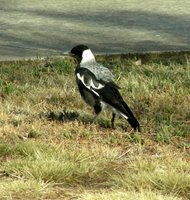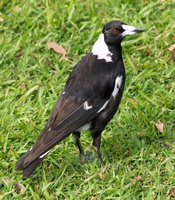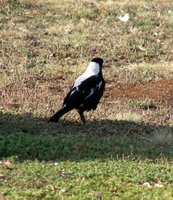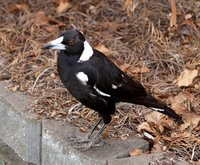Not a bad view, you know. The gums are flowering so they're usually full of white-plumed honeyeaters and red wattlebirds, with the occasional silver eye and New Holland honeyeater. For some reason the lorikeets are ignoring these trees but eastern rosellas pop in from time to time. Just the young ones, still with their green feathers. And there are always magpies.
 I love magpies (Gymnorhina tibicen). When I introduced an overseas friend* to their glorious carolling he told me they sounded like R2D2. Which is true—they do. But it's a very musical version of R2D2.
I love magpies (Gymnorhina tibicen). When I introduced an overseas friend* to their glorious carolling he told me they sounded like R2D2. Which is true—they do. But it's a very musical version of R2D2.Geographical variation in colour pattern has led to speculation that there are several species of magpie but all are now regarded as forms (morphs) of a single widespread species. Each morph is divided into several subspecies.
 The most abundant morph is the black-backed form, which occurs over much of Australia. This includes one western and three eastern subspecies.
The most abundant morph is the black-backed form, which occurs over much of Australia. This includes one western and three eastern subspecies.The white-backed form is restricted to coastal regions of SE Australia, from the eastern end of the Nullabor Plain to the far eastern Victoria – New South Wales border. And, of course, there's more than one subspecies. Apparently three of 'em are jammed into that small area.
 Just before you think that you've got it all under control, there's a third form, Gymnorhina tibicen dorsalis, in SW Western Australia. In this subspecies, the males have white backs and the females black. Where the various forms meet, there is intergradation from one to the other.
Just before you think that you've got it all under control, there's a third form, Gymnorhina tibicen dorsalis, in SW Western Australia. In this subspecies, the males have white backs and the females black. Where the various forms meet, there is intergradation from one to the other.So why is there such variation? Scientists have proposed two hypotheses. The pattern is either due to:
- Past isolation resulting in differentiation of plumage local populations, followed by range expansion that has brought the populations back into contact
- A continuous distribution (no isolation) with local conditions affecting plumage
 Genetic studies on these populations shows that there's not a lot of evidence for isolation alone as the diversifying force. Colour patterns seem to be maintained by one or more selective pressures acting on different populations. Researchers in Queensland have found some indication that back colour in males is related to success in raising fledglings. If predators can't spot the nests in tree crowns, they can watch the parents returning to feed their chicks. Black-backed males may be less obvious to predators in open vegetation than are the white-backed males. If this is the case, then populations with white-backed male will be restricted to those areas where vegetation is dense—the SE and SW.
Genetic studies on these populations shows that there's not a lot of evidence for isolation alone as the diversifying force. Colour patterns seem to be maintained by one or more selective pressures acting on different populations. Researchers in Queensland have found some indication that back colour in males is related to success in raising fledglings. If predators can't spot the nests in tree crowns, they can watch the parents returning to feed their chicks. Black-backed males may be less obvious to predators in open vegetation than are the white-backed males. If this is the case, then populations with white-backed male will be restricted to those areas where vegetation is dense—the SE and SW.It's not known whether this is the explanation for the colour morphs but it is an explanation. And one open to further study.
I just think magpies are wonderful singers. And to hear one of these fabulous warblers doing her stuff, check out the link in the second comment below.
[Photos from top to bottom: WB juvenile; BB adult; WB adult; BB adult. White-backed birds photographed in Melbourne. Black-backed birds photographed in northern New South Wales. Many thanks to Tapperboy for taking those photos.]
References
Hughes, J.M., Lange, C.L., Mather, P.B. & Robinson, A. (2002). A comparison of fitness components among different plumage morphs of the Australian Magpie, Gymnorhina tibicen.
Toon, A., Hughes, J., Baker, A. & Mather, P. (2003). Discordance between morphology and genetic structure among three plumage forms of the Australian Magpie. Emu 103: 337 – 343.
_______
*You know who you are!